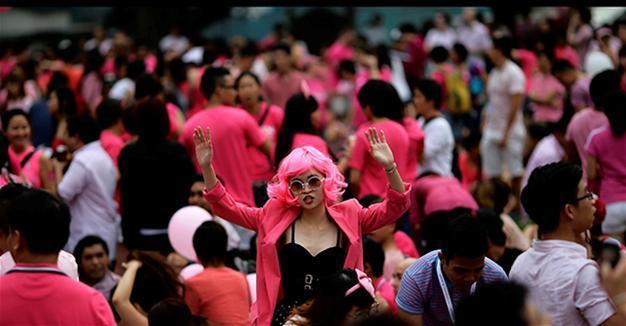Turkey’s women had enough of pink
Nazlan Ertan - nazlanertan@gmail.com

REUTERS photo
In the 1927 musical “Funny Face,” the formidable Miss Prescott – a character based on Vogue’s legendary editor-in-chief Diana Vreeland – announces her decision that her fashion magazine would urge all women to dress in nothing but pink.
“I would not presume to tell a woman what to think, but if she needs to think, think pink,” she sings as the old-fashioned musical breaks into a scene where gorgeous dancers are seen in all sorts of “lady-like” poses, such as shopping in pink, dancing in pink, cooking in pink and brushing their teeth with pink toothpaste.
I suspect my dislike of pink is rooted in that movie, which I watched as a little girl, along with all American musicals with my mother, who loves Shakespeare and Gene Kelly. She confirms that I have always hated pink and protested violently when anything in pink, the color of gifts for girls, was given to me as a present, even as a child.
Growing up in Turkey, it is easy to see how pink can become the color of segregation. Pink often has a degrading quality to any noun to which it is attached, mainly because it refers to some semi-realistic rosy universe that is essentially female and almost always related to over-sweet romance or Barbie-type beauty.
The Turkish language boasts expressions such as “pembe hayaller” (pink dreams), which refer to the romantic or conjugal dreams of a young woman. A “pembe panjurlu ev” (house with pink shutters) refers to the desire for a home and family, often pronounced with a smirk by men who believe that women’s dearest desire is a luxury kitchen and three crying kids. It is no coincidence that “Pembe Panjur” is also the name of one of the many online matchmaking sites. It prides itself on being focused on long-relationship and marriage – possibly as opposed to other sites where flirting, short-term relationships or good-ol’ one-night-stands are also among the options. Men wearing pink or admitting to drinking “blush” are relatively new; older men simply brush away the color as “feminine” or “gay” and stay away from it. In another case, Elif Şafak’s pink-covered book “Forty Lessons of Love” was published with an alternative gray cover to attract male customers, who originally thought that it was “pink romance.”
But no use of pink is as chauvinist as in “pink” buses, “pink” wagons or “pink” cafes. Earlier this week, Bursa – one of Turkey’s most industrialized cities – has announced that it will have a pink wagon so that women passengers can commute “without being harassed by men.” The experience is not unique in Turkey. Two years ago, the southeastern province of Şanlıurfa launched pink public buses – for women only. The decision came in after the brutal murder of Özgecan Aslan by a minibus driver who tried to rape her.
Pink transport is a recurrent theme in the Turkish political rhetoric. It has become more insistent and more dominant in the ruling Justice and Development Party’s (AKP) last decade but the idea did not start there. In the 1980’s and 1990’s, some portly politician or a well-meaning local authority would air the idea, only to be shouted down by women activists. In the late 1980’s, women responded to the idea of pink transport with a colorful campaign of their own: Purple-headed pins to stab the hand that would grope them in a bus! If pink was the color of tepid, protected femininity; the color purple belonged to the intrepid women of the world, a throw-back to Clytaemnestra, the wife of Agamemnon in Greek mythology, who makes her husband walk on a carpet of purple before she murders him to avenge Agamemnon’s sacrifice of their daughter Iphigenia.
Pink as a women’s only color is not limited to Turkey. Earlier this month, Al-Monitor published the story of a “Pink Café” in Luxor, upper Egypt. These cafes are common in Saudi Arabia, Gaza and other parts of Egypt. Mostly, they are regarded favorably because it means women can go out. Reham Mokbel’s article quotes Basma al-Khatib, the director of women’s issues at the For Egypt Association in Qena, as saying that any women-only project contributes to further isolation of women in a society that believes women should remain hidden.
Women are not creatures to be wrapped in pink clouds of protection. “Don’t put me in a pink bus, put harassers behind bars,” said a tweet in the wake of the pink wagon debate. A few weeks ago, satirist magazine Uykusuz featured a cartoon in which two men in a bus whisper about a woman: “If she has taken the regular bus instead of the pink one, she must be a slut!”
Şirin Tekeli, a leading figure of Turkey’s feminist movement who passed away earlier this week, was the founder of Purple Roof Women’s Shelter Foundation, which opened one of the first women’s shelter. She was the quintessential anti-pink woman, a purple-clad feminist.
In the Aegean port city of İzmir, there are no pink buses. Pink is worn more often by men than women.
Halfway into the musical “Funny Face,” Miss Prescott decides that she has had enough of pink and decides to use school-marmish Audrey Hepburn, black sweaters, white shirts and a nose buried in a book, as her new fashion icon.
The idea behind it is “Better think than pink!” And yes, too much pink clearly brings its own downfall.
